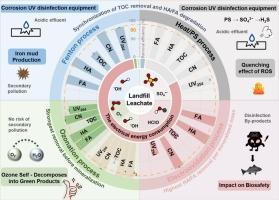不同深度氧化工艺对垃圾渗滤液生物处理出水有机物去除率及能耗的比较
IF 6.7
2区 工程技术
Q1 ENGINEERING, CHEMICAL
引用次数: 0
摘要
虽然高级氧化工艺(AOPs)可以消除垃圾渗滤液生物处理(MBR)出水中残留的顽固有机化合物,但主要活性氧氧化特性的差异导致去除模式不同。此外,由于缺乏对其去除效率和能耗的系统比较,难以指导实际应用。以TOC矿化为主要指标,评价了Fenton、heat/PS、臭氧(O3和UV/O3)和电氧化(Ru-Ir/Ti-EO) AOPs的去除效率和能耗。分析了UV-Vis和3D-EEM光谱来评估去除模式。结果表明,各工艺对有机物的去除率随氧化强度的增大而增大。色数(CN)、腐植酸(HA)和黄腐酸(FA)的去除率均超过90%,总有机碳(TOC)去除率为24.05% ~ 91.68%,腐殖化指数(HIX)降至0.47 ~ 1.72。Ru-Ir/Ti-EO工艺对单位矿化质量的HA和FA去除率最高。Fenton和heat/PS工艺可以同步去除TOC与FA和HA降解。在有机质矿化前,臭氧氧化的去除能力最强。然而,Fenton工艺、heat/PS工艺和Ru-Ir/Ti-EO工艺的高能耗和环境风险限制了它们的应用潜力。相比之下,臭氧化工艺消耗的能量少1-2个数量级,由于其有效性和低二次污染风险,使其成为MBR废水处理的首选。本文章由计算机程序翻译,如有差异,请以英文原文为准。

Comparison of the removal efficiency and energy consumption of different advanced oxidation processes on the removal of organic matter in the effluent from the biological treatment of landfill leachate
While advanced oxidation processes (AOPs) can eliminate residual recalcitrant organic compounds in effluent from the biological treatment (MBR) of landfill leachate, differences in the oxidation characteristics of the dominant active oxygen species lead to varying removal patterns. Additionally, the lack of systematic comparisons of their removal efficiency and energy consumption makes it difficult to guide practical applications. This study evaluated the removal efficiency and energy consumption of Fenton, heat/PS, ozonation (O3 and UV/O3), and electrooxidation (Ru-Ir/Ti-EO) AOPs, using TOC mineralization as the main index. UV–Vis and 3D-EEM spectra were analyzed to assess the removal patterns. The results show that the removal efficiency of organic matter by each process increases with increasing oxidation intensity. The removal efficiencies of color number (CN), humic acid (HA), and fulvic acid (FA) exceeded 90 %, with total organic carbon (TOC) removal ranging from 24.05 % to 91.68 % and the humification index (HIX) decreasing to 0.47–1.72. The Ru-Ir/Ti-EO process showed the highest HA and FA removal efficiency per unit mineralized mass. The Fenton and heat/PS processes can synchronize TOC removal with FA and HA degradation. The ozonation process had the strongest removal ability before organic matter mineralization. However, the high energy consumption and environmental risks of the Fenton, heat/PS, and Ru-Ir/Ti-EO processes may restrict their application potential. In contrast, the ozonation process consumes 1–2 orders of magnitude less energy, making it a preferable option for MBR effluent treatment due to its effectiveness and low risk of secondary pollution.
求助全文
通过发布文献求助,成功后即可免费获取论文全文。
去求助
来源期刊

Journal of water process engineering
Biochemistry, Genetics and Molecular Biology-Biotechnology
CiteScore
10.70
自引率
8.60%
发文量
846
审稿时长
24 days
期刊介绍:
The Journal of Water Process Engineering aims to publish refereed, high-quality research papers with significant novelty and impact in all areas of the engineering of water and wastewater processing . Papers on advanced and novel treatment processes and technologies are particularly welcome. The Journal considers papers in areas such as nanotechnology and biotechnology applications in water, novel oxidation and separation processes, membrane processes (except those for desalination) , catalytic processes for the removal of water contaminants, sustainable processes, water reuse and recycling, water use and wastewater minimization, integrated/hybrid technology, process modeling of water treatment and novel treatment processes. Submissions on the subject of adsorbents, including standard measurements of adsorption kinetics and equilibrium will only be considered if there is a genuine case for novelty and contribution, for example highly novel, sustainable adsorbents and their use: papers on activated carbon-type materials derived from natural matter, or surfactant-modified clays and related minerals, would not fulfil this criterion. The Journal particularly welcomes contributions involving environmentally, economically and socially sustainable technology for water treatment, including those which are energy-efficient, with minimal or no chemical consumption, and capable of water recycling and reuse that minimizes the direct disposal of wastewater to the aquatic environment. Papers that describe novel ideas for solving issues related to water quality and availability are also welcome, as are those that show the transfer of techniques from other disciplines. The Journal will consider papers dealing with processes for various water matrices including drinking water (except desalination), domestic, urban and industrial wastewaters, in addition to their residues. It is expected that the journal will be of particular relevance to chemical and process engineers working in the field. The Journal welcomes Full Text papers, Short Communications, State-of-the-Art Reviews and Letters to Editors and Case Studies
 求助内容:
求助内容: 应助结果提醒方式:
应助结果提醒方式:


